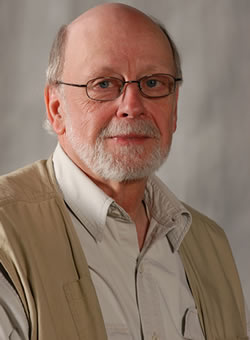By Craig Wilkins

Craig Wilkins, frequent transit rider and history buff, has worked in Mn/DOT's Office of Communications since 1980. Photo by David Gonzalez |
Editor’s note: The Minnesota History Center in St. Paul currently features three exhibits that tell the story of transportation in Minnesota. Transportation is an integral part of the MN150 exhibit, which traces Minnesota’s 150-year history as a state. The long-standing “Going Places: The Mystique of Mobility” exhibit traces the history of transportation in Minnesota . Another exhibit, “Right on Lake Street,” profiles one of Minneapolis’s major east-west routes. (The Lake Street exhibit closes March 9.)
I live just a few blocks from Lake Street and I’ve been a regular bus rider since I joined Mn/DOT in 1980. Each day my commute takes me along the eastern one-third of Lake Street.
That’s why I was drawn to the History Center’s Lake Street exhibit.
Enter the exhibit and a mock up of the legendary Route 21 bus invites you to sit down and ride.
No fare is required—visitors travel the six-mile route from Lake Calhoun six miles east to the Lake Street Bridge via a DVD projected on the bus’s windshield.
The video tour rolls past landmark stores, historic buildings, a Civil War era cemetery and about 150 restaurants. I visit many of them often.
Lake Street evolved from a footpath once used by the Dakota people to a vibrant avenue of commerce, culture and communication.
The footpath widened into a dusty, often muddy street jammed with pedestrians, horse-drawn vehicles and hordes of bicyclists.
During the 1890s Lake Street was paved with cinders as traffic demands grew. In the early 1900s, electric streetcars provided transit for commuters.
The streetscape changed again in the 1950s when the streetcar system was scrapped and replaced by buses.
Lake Street reinvents itself to stay vital and relevant.
In 1907, immigrants from Germany started Schatzlein’s Saddle Shop at Lake and Grand Avenue. The shop first served farmers who drove their rigs in to get harnesses and other gear repaired. Today the store serves recreational equestrians and people fond of Western style boots, hats and other clothing.
Ingebretsen’s, a Scandinavian food and specialty store, still thrives at its original Lake Street location.
Immigrants keep coming to Lake Street to begin new lives and enterprises. A trip down Lake Street today reveals how immigrants from Africa, Asia and Latin America have revitalized the street from a serious downturn in the 1970s and 1980s.
The once-shuttered Sears store was renovated for offices, a hotel, apartments and the Midtown Global Market.
My bus is, in a sense, a rolling continuation of the street. There is conversation, interests are shared, friendships formed, connections made.
After our son Ethan was born in 1986, our fellow passengers held a baby shower for my spouse and me as we rode down Lake Street on the way to St. Paul.
Ethan is now 21, his favorite Lake Street stop is Manny’s Tortas at 27th Avenue. His mother, Candace, and I like to visit the Town Talk Diner, just across the street.
Lake Street is a constant thread in my life.
Riding the bus helps keep me in touch with neighbors, other government workers and my own sense of place in the world.
On a bright morning a few years ago, I boarded my bus at 36th Avenue and Lake Street. The bus was nearly full. I took the first seat available, one next to a young Somali woman holding a large bouquet of yellow roses.
She moved over a bit, but the long-stemmed flowers still inched into my space. I looked down at the flowers and looked up at her. I hesitated for a moment, then asked, “Oh, are these roses for me?”
She paused, took one rose out of the wrapped bunch and handed it to me.
“Well, not all of them,” she said, “but this one is for you.”
This could have happened most anywhere, but it’s more likely on the bus.
|



